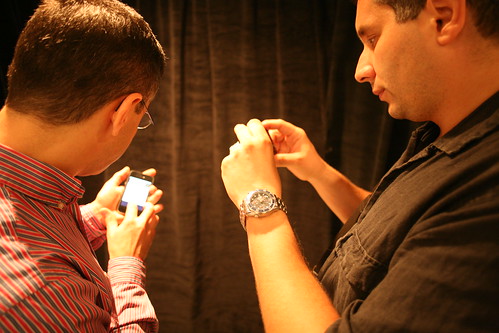We’ve arrived in Barcelona, Spain for Nokia World, a week where Nokia talks to its top customers.
When we got here a Nokia executive met me and bragged that the Internet has no clue what they will announce this week. I asked “what about the touch screen cell phone that I’ve seen rumors about?” He said that no one had gotten it right yet. The announcements are on Wednesday morning (it’s early Monday morning as I post this) so we’ll have to wait to see what they announce. He told me this is one of the only times he can remember when a big announcement has not leaked. He said that even internally only a handful of people have seen the new device they’ll be announcing on Wednesday. Does that tactic sound familiar? It should, and is only one of the reasons why this is Nokia’s touchiest week.
This is the week when Nokia either keeps its seat at the cell-phone-thought-leadership table or it will give up its spot to Apple and RIM alone.
Here’s some datapoints.
1. At the recent Salesforce.com conference CEO Marc Benioff asked the audience what cell phone they used. 35% answered iPhones. That’s incredible. Apple has gotten HUGE market share among enterprise users, despite having a huge wall setup against them.
2. RIM was used by almost everyone else at Salesforce. Nokia? Hah.
3. When I traveled to China the thought leaders there bragged about their iPhones. Same in Tel Aviv, Israel. These are places that are HUGE Nokia strongholds and that have almost no Apple stores.
4. Apple is just about to pass 10,000 apps for the iPhone, says Webware. Developers are picking iPhone big time. Why is that? Because Apple has thought leadership that Nokia has squandered.
Translation: this is the week that Nokia either shines or moves to the B list of the cell phone market. Yeah, you won’t know how this week turned out for a year or two, but there is no bigger week for Nokia.
Now, can you count Nokia out yet? No way. It has the biggest slice of the cell phone marketshare pie. Its devices are much better engineered than Apple’s are (GPS on Nokia is better, so are the antennas, the cameras, and bluetooth radios that Nokia uses). But engineering does NOT equal a great experience. Yeah, my Nokia does not drop phone calls in places in Silicon Valley that my iPhone does, but generally I reach for the iPhone when I want to make a call or surf the web. Why?
Nokia is behind in experience. The executives here from Nokia that I’ve talked to know that. They know this is Nokia’s touchiest week and one where they either deliver a much better device or they are going to face a very tough 2009 globally.
Oh, and how do you figure out what kinds of new features are coming soon? You visit the suppliers of Nokia like I did last week. I went to Broadcom where I met with (and videoed) the team that does the GPS chip inside your cell phones.
What did they tell me? Well, first, look at how much smaller that Broadcom chip is compared to the prototype that team built back in 2000. Can they make it even smaller? The team says “yes.” How? They are now combining chips. In your cell phone today is three chips. One for GPS. One for Wifi. One for Bluetooth.
Broadcom now makes one chip with all three features. That means longer battery life, lower cost, smaller form factor so you can have sexier phones that are thinner and smaller. By the way, the videos I shot with Broadcom explain how GPS works and how they are making it better so it works even inside buildings. Think that one small group of people can’t change the world? These engineers did. They are now working on new chips that also include MEMS (micromachines on silicon) that will include things like accelerometers (like the iPhone has). As I was leaving, the Broadcom PR people said they were “just about” to announce new chips. Is Broadcom waiting for Nokia to announce its new device? I hope so.
So, what do you think Nokia is going to release on Wednesday? Will it take “touch” and “experience” leadership back from Research in Motion and Apple?
More from Nokia World all week.
